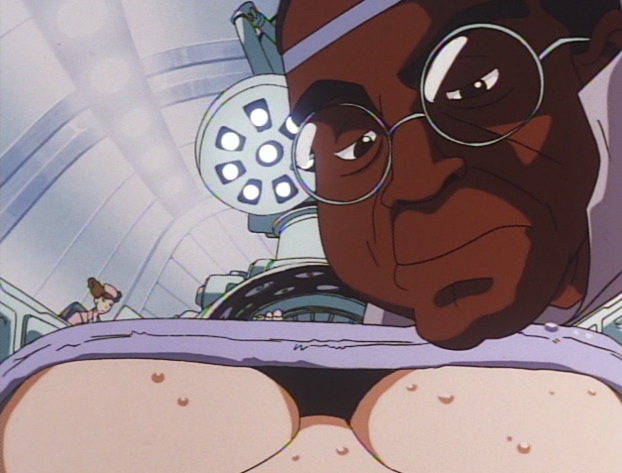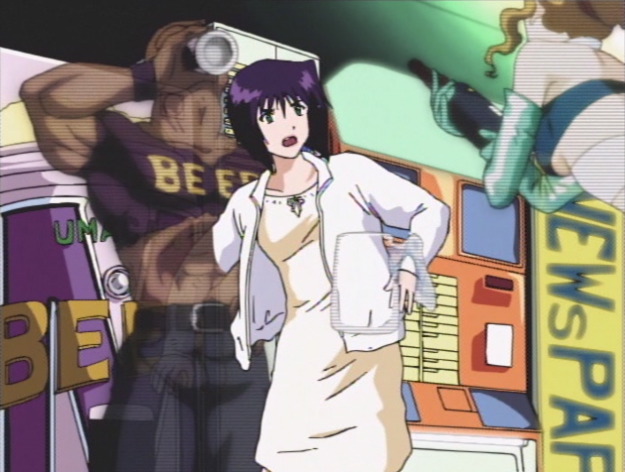
Diagnosis: Fan Service.
So much for the tale. Let’s back up and talk about the way that it’s told. Like I said already, this is basically about the development of Faye’s personality. And this story arc informs the visual vocabulary of the episode in some interesting ways.
Pictured above is one of the first shots in the flashback – maybe not the very first, but it’s pretty much our introduction to the world of the narrative. What’s important here is not the pointless leering at breasts: it’s the fact that this is from Faye’s POV. Now we have had POV shots in Cowboy Bebop before, and pretty frequently. It’s such a standard part of the cinematic vocabulary that it would be hard to avoid them. But the whole flashback here is absolutely riddled with shots from Faye’s point of view, and what’s more, they call attention to the fact that they are POV shots as such, by including parts of her body in the frame, or by tracking with her vision, shakey-cam style, as she glances around the room.
This is a neat trick because it encourages the audience to identify with Faye as she encounters the (to 1998 audiences) strange new world of the 21st century. Somewhat unusually for sci-fi, Cowboy Bebop has never been a technophilic or a technophobic show. Rather, technology is simply there, always taken for granted. My Funny Valentine is the only episode I’ve seen where this is not the case. Because Faye is a stranger here herself, she is startled and amazed by each new technological wonder. And we, the audience, are along for the ride. (In a series with different priorities, this would have been an ideal pilot episode.)

It's like the whole audience is groping the hologram along with her.
And I think – I still haven’t seen the end of the series, but I’m guessing, here – these POV shots also suggest that we should start shifting our major emotional identification in the show off of Spike and onto Faye. Because they aren’t just in this episode alone, as you will see.
The other interesting thing about the episode is the musical montage, set to another Yoko Kanno original called “Flying Teapot.” Start at around 1:40 in this video.
http://www.youtube.com/watch?v=Tqug6wIflYA
I’ve got to say, this one does not do a whole heck of a lot for me as music. It sounds like a kind of middling Sondheim knockoff with really awkward lyrics (“Look at them, they are cheeky/ they are never worthy,” with melodic accents on the final “y” of cheeky and worthy, is not the kind of text setting a native speaker of English would be likely to come up with). And even Sondheim’s music is – I mean, it’s wonderful stuff, but it’s there to serve the lyrics, always, so a Sondheim song with bad lyrics would not be a very good song. I’ve managed to develop a certain grudging, perverse affection for Flying Teapot through repeated exposure. But it’s certainly not the striking thing about this sequence. What is striking is the way that Faye starts out infantilized, literally riding piggy-back in a childish nightgown, and comes out of the song as a fully fledged adult in a va-va-voom dress. They don’t quite run her through Maslow’s hierarchy of needs, but it’s pretty close. First you see her eating, still in the nightgown (physiological needs), then learning to read while wearing clothes with a late adolescent vibe (not something Maslow specifically mentions, as far as I know, but it fits into the basic control over one’s environment that characterizes the “safety” stage), and then finally shopping for a nice dress (symbolic of financial security, although we all know she doesn’t have that, which is again a “safety” thing) before she can open up her heart to her (creepy) (father-figure) lawyer, and finally move on to the final stage of the pyramid: getting chased by a helicopter. I kid, I kid. Obviously we have to take this analogy with a grain of salt. But it’s at least interesting, certainly, that she sort of gets “blocked” at the love/belonging stage, and never gets as far as self-esteem or self-actualization. Which again would explain a fair amount about the character.
If we’re going to take the psychoanalytic reading and run with it, let’s also revisit the whole “that’s not an X, it’s a Y!” sequence I mentioned before. This scene has Faye basically as a newborn. She’s unaware of her self (in that she doesn’t remember anything). She’s unaware of the world (in that she has no idea what year it is). Also, and this is the tricky one, she has not yet learned how to see. By which I mean that she has not learned how to associate visual data with objects in the real world. By which I mean that, yes, the photons bouncing off of the machine are hitting her eyes, but she does not have a symbolic concept of washing-machine-ness to map those images onto.
Trying to talk around the idea is brutally hard. It’s probably much better just to watch that sequence again (an English lanuage version of the episode was floating around youtube last I checked, but it didn’t allow embedding), and try to keep in mind that there was a time, for all of us, when every object in the world was just as mysterious – that we, like Faye, had to learn to see the washing machine. And then think about the fact that while watching the episode, you were not actually seeing a washing machine, but a representation of a washing machine! And we all had to learn to do that too.
One last thing is worth mentioning. On the more immediate level of character development, it’s significant that Faye seems to forgive Whitney at the end and begin moving on with her life. I mean, she throws him in jail, which is not exactly consistent with forgiveness… but something about the way it’s framed and performed still gives you a pretty clear impression of forgiveness. This is probably significant.
All right, that does me for now. Tune in tomorrow for discussion of the other three episodes on the disc.
New to OI – went back and read all the Cowboy Bebop posts, because I loved that series with all my little heart. Alone of all the anime I’ve seen, it bears repeated watching (although not often). So thank you for this; I’m still kinda convinced, though, that it’s not possible to overthink CB. It was, for anime, incredibly well-written.
I just found this site today while looking for something else Bebop related and I’m rolling off the couch laughing.
I love your observations, and even where I don’t agree with everything you say, I find myself laughing myself sick anyway. I have to tell everyone about this.
If I may add my two woolongs on the comment thread relating to the dub of the series and the lines that differed (the system wouldn’t allow me to post a comment there)…
The Japanese language takes way more syllables (for the most part) to express the same thought than English does. Cowboy Bebop, like anime in general, was written by Japanese people and was voiced by Japanese actors who were speaking Japanese. The animation’s mouth movements accommodated the Japanese actors’ voices.
There is a problem with matching the actors’ voices with the mouth animations when dubbing into different languages. They need to have the words the actors’ voices are speaking match the mouth animation. The result of this is lines are changed – stuff is added, left out or in some extreme cases changed completely (a glaring example of this is in Ballad of Fallen Angels. In the sub, Spike tells Jet “Let’s just say obligations of the life I lead” where in the dub the actor’s voice says “Looks like my past is catching up with me.”).
If I want to know what the characters are really saying, I watch the sub. Not to say the subtitles aren’t sometimes wrong, but at least the lines weren’t deliberately changed so the animation looks better with the voices.
I’m really looking forward to your take on Real Folk Blues. Does it annoy you as much as it annoys me?
I love this feature! I just recently watched the whole series through myself for the second time.
In terms of sub vs. dub, Bebop probably has one of the best dubs you’ll hear. As an interesting experiment, try watching it in English but with Japanese subtitles; it’s interesting how they get the same point across using different languages!
Now where’s the second part? Also, are you gonna Overthink the movie as well?